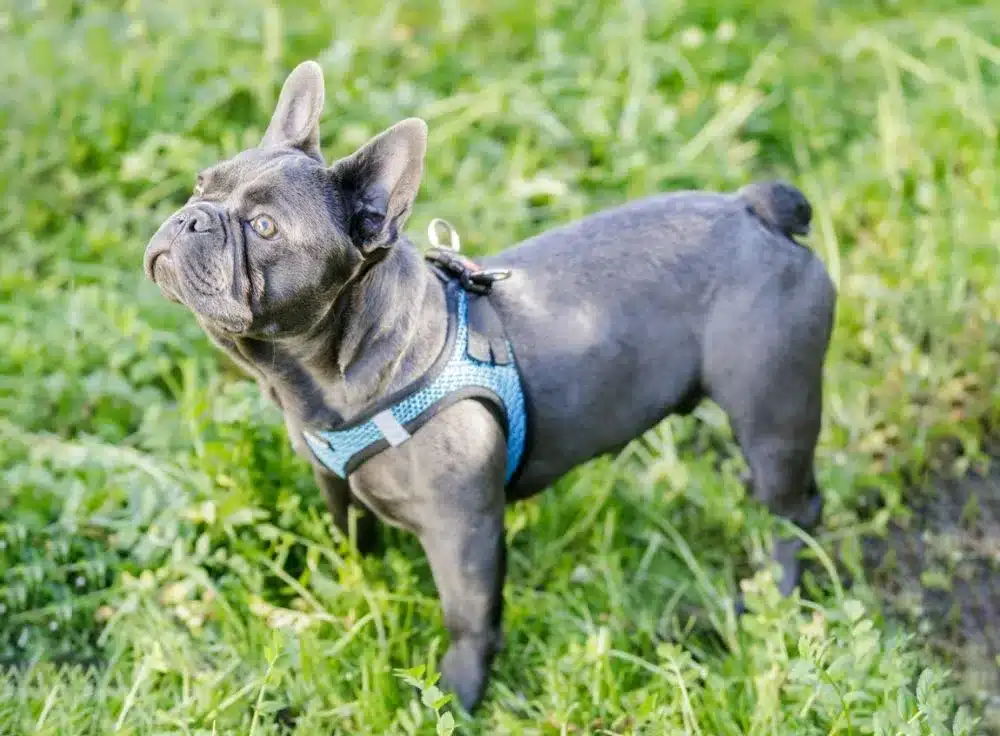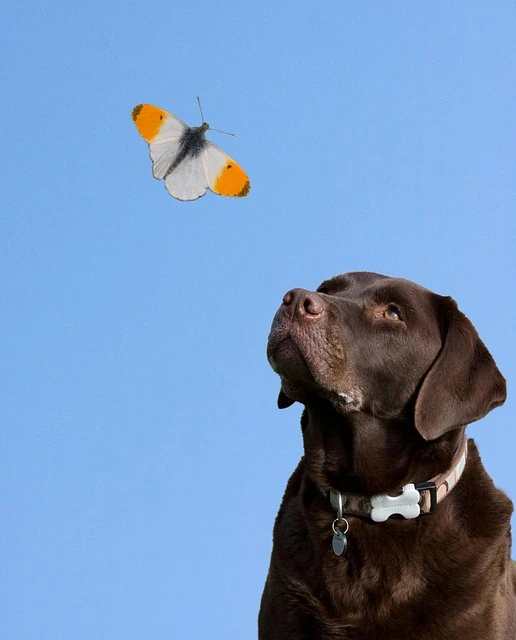
Picture this: you come home after a long day, and instead of a hyperactive dog bouncing off the walls demanding hours of exercise, you’re greeted by a gentle companion who’s perfectly content to curl up beside you on the couch. Low energy dog breeds offer the perfect solution for dog lovers who want loving companionship without the commitment to marathon exercise sessions. These calm, relaxed breeds make excellent pets for seniors, apartment dwellers, busy professionals, and families seeking a more peaceful household dynamic.
Table of Contents
While every dog needs some daily exercise and mental stimulation, low energy dog breeds typically require just 30-60 minutes of gentle activity per day—think leisurely walks and indoor play rather than intense hiking or jogging sessions. Let’s explore the wonderful world of mellow canine companions who prove that the best dogs aren’t always the most energetic ones.
Understanding Low Energy Dog Breeds: What Makes Them Special
Low energy dogs, often affectionately called “couch potato dogs,” possess naturally calm temperaments and lower exercise requirements compared to their high-energy counterparts. However, it’s crucial to understand that low energy doesn’t equal low maintenance—these dogs still require proper nutrition, regular veterinary care, grooming, and mental stimulation to thrive.
Key Characteristics of Low Energy Breeds
These relaxed companions typically share several common traits that make them ideal for calmer households. Most low energy breeds prefer lounging and observing their surroundings to constant activity, showing contentment with indoor relaxation and shorter outdoor adventures. They often display gentle, patient temperaments that make them excellent family pets, especially around children and elderly family members.
According to the American Kennel Club, “Your dog’s breed heavily influences the level of physical activity they need. High-energy breeds require a lot more exercise than lower-energy breeds.” This breeding heritage plays a significant role in determining your dog’s natural energy level and exercise requirements.
According to the American Kennel Club, ‘Your dog’s breed heavily influences the level of physical activity they need. High-energy breeds require a lot more exercise than lower-energy breeds.’ This breeding heritage plays a significant role in determining your dog’s natural energy level and exercise requirements.
Who Benefits Most from Low Energy Dogs
Low energy breeds are particularly well-suited for several types of households. Seniors seeking loyal companionship without demanding exercise routines find these breeds perfect partners. Apartment dwellers appreciate dogs that don’t require large yards or extensive daily runs. Busy professionals who can’t commit to hours of daily exercise still want the joy of dog ownership. Families with young children often prefer calmer dogs that won’t accidentally knock over little ones during play.
First-time dog owners frequently find low energy breeds more manageable as they learn the ropes of responsible pet ownership. People with mobility challenges or health conditions that limit their ability to provide intensive exercise can still enjoy the incredible bond that comes with dog ownership.
Small Low Energy Dog Breeds: Big Personalities in Compact Packages
French Bulldog

The charming French Bulldog tops many lists of low energy companions, and for good reason. These bat-eared beauties were bred specifically for companionship, making them natural couch potatoes who thrive on human attention. Weighing 20-28 pounds, Frenchies are perfectly content with short walks and indoor playtime.
As a brachycephalic breed (flat-faced), French Bulldogs shouldn’t be over-exercised, especially in hot weather. A 20-30 minute walk and some gentle indoor games typically satisfy their exercise needs. Their adaptable nature makes them excellent apartment dogs, though they can be somewhat vocal when excited.
Our top pick for French Bulldog comfort: BENEBONE Wishbone Durable Dog Chew Toy. This bacon-flavored chew provides mental stimulation during their frequent rest periods and is designed for their unique jaw structure.
Cavalier King Charles Spaniel

These elegant toy spaniels combine the perfect balance of gentle energy and adaptability. The cavalier King Charles spaniel is known for its calm disposition and adaptability. They make excellent family companions and love spending their days indoors with lots of cuddles and playtime. Weighing 13-18 pounds, Cavaliers are happy to match their energy level to their owner’s lifestyle.
Originally bred as lap dogs for royalty, Cavaliers retain their love of comfort and close human contact. They enjoy daily walks but are equally content with indoor play sessions. Their sweet, patient nature makes them exceptional therapy dogs and wonderful companions for children.
Shih Tzu

The Shih Tzu, literally meaning “lion dog,” was bred exclusively as a companion for Chinese royalty. These 9-16 pound dogs embody the lap dog lifestyle, preferring indoor comfort to outdoor adventures. Their exercise needs are easily met with short daily walks and indoor play sessions.
A toy breed originally bred as a companion dog for Chinese royalty, Shih Tzus are happy to live a life of luxury and relaxation. While their gorgeous flowing coat requires regular grooming, many owners opt for the adorable “puppy cut” for easier maintenance.
We recommend: Hertzko Self-Cleaning Slicker Brush for maintaining their beautiful coat during daily bonding sessions.
Pug

Pugs pack enormous personality into their compact 14-18 pound frames. These wrinkled comedians were bred to be companions and excel at their job with minimal exercise requirements. Their flat faces mean they’re built for short bursts of play followed by plenty of rest.
A typical Pug day includes a short morning walk, some indoor playtime, and lots of napping in sunny spots. Their social nature means they prefer being with their families rather than alone, making them excellent companions for people who work from home.
English Bulldog

The iconic English Bulldog represents the ultimate in canine relaxation. These 40-50 pound gentle souls were bred for a different purpose originally, but today’s Bulldogs are all about comfort and companionship. Their sturdy, low-slung build and flat faces make them unsuitable for intense exercise, which perfectly suits many owners’ lifestyles.
With their stocky build and easy-going nature, English Bulldogs are the epitome of low-energy dogs. A couple of short walks and some gentle indoor play typically satisfy their exercise needs. However, owners must be vigilant about heat sensitivity and should avoid exercising them during hot weather.
Essential for Bulldogs: Elevated Cooling Dog Bed helps regulate their body temperature and supports their joints during their many nap sessions.
Medium Low Energy Dog Breeds: The Perfect Balance
Basset Hound

With their distinctive long ears and soulful eyes, Basset Hounds embody the laid-back lifestyle while maintaining their hunting heritage. These 40-65 pound scenthounds are perfectly content with moderate daily walks that allow them to explore interesting smells.
The Basset Hound needs to use their nose daily to stay happy! You can enjoy many scavenger hunts and other scent-related tasks with your pup. Their short legs and long bodies make them natural for a more relaxed pace, though they still enjoy outdoor adventures that engage their incredible sense of smell.
Whippet

Despite being bred for speed, Whippets are surprisingly low-maintenance companions. These 25-40 pound sighthounds are often called “40-mile-per-hour couch potatoes” because they enjoy brief bursts of running followed by extensive lounging periods.
A typical Whippet exercise routine involves a short sprint in a fenced area followed by hours of comfortable napping. Their gentle, quiet nature makes them excellent apartment dogs, though their thin coats mean they appreciate warm bedding and clothing in cold weather.
Perfect for Whippets: RC Pet Products Whistler Winter Wear Coat keeps these lean dogs comfortable during cooler weather walks.
Chow Chow
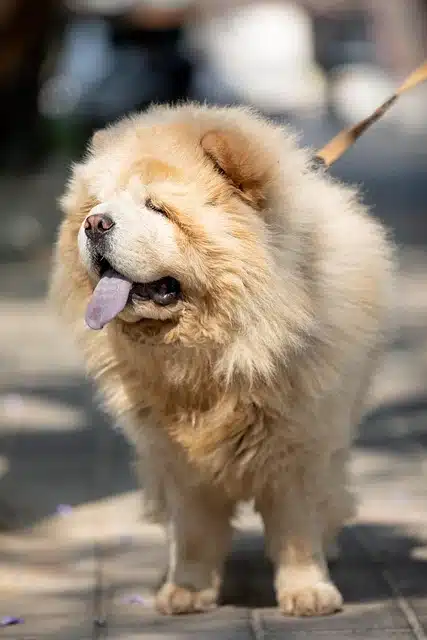
The regal Chow Chow brings an independent, cat-like personality to the dog world. These 45-70 pound dogs are naturally reserved and prefer a calm household environment. Their exercise needs are moderate—daily walks and some playtime satisfy their requirements while respecting their dignified nature.
Chow Chows are naturally clean and quiet, making them suitable for various living situations. However, their thick double coat requires regular grooming, and their independent nature means they benefit from early socialization and consistent training.
Large Low Energy Dog Breeds: Gentle Giants
Great Dane
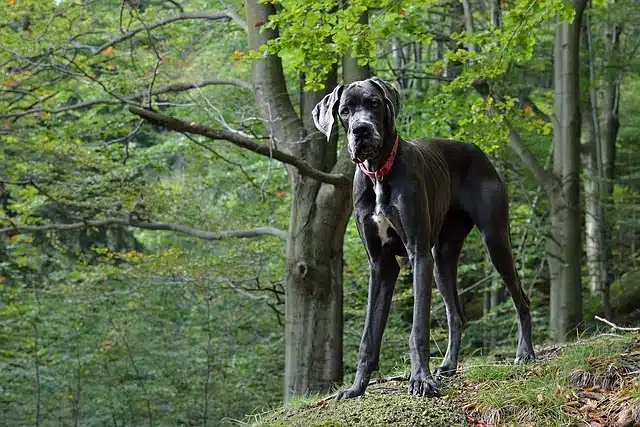
Perhaps surprisingly, these towering giants are among the most relaxed dog breeds. Great Danes are famous for being gentle, calm companions who prefer lounging to lengthy exercise sessions. Despite their imposing size (120-175 pounds), they’re often called “gentle giants” for their patient, affectionate nature.
Great Danes, true to their ‘gentle giant’ nickname, are known for their surprisingly low-energy nature. Despite their imposing size, they are affectionate and love lounging around the home. They do require daily walks and some playtime, but their exercise needs are quite reasonable given their size.
Saint Bernard
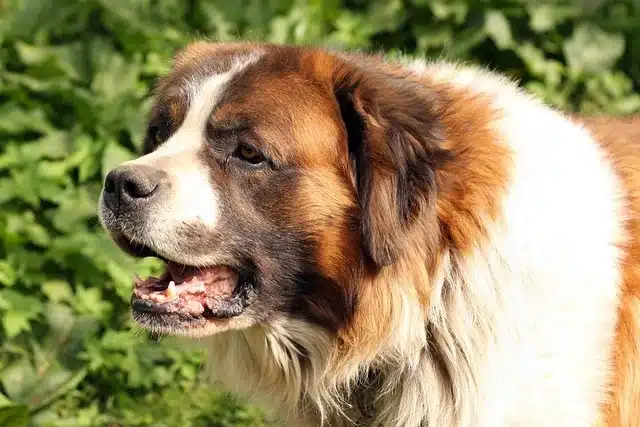
These legendary rescue dogs from the Swiss Alps are naturally calm and patient. Weighing 120-180 pounds, Saint Bernards are gentle, laid-back dogs who make excellent family companions. Their rescue heritage gave them patient, thoughtful temperaments that translate perfectly to family life.
Saint Bernards enjoy moderate daily exercise but are equally content relaxing with their families. Their thick coats make them more comfortable in cooler weather, and their gentle nature makes them excellent with children.
Essential for large breeds: Big Barker 7″ Orthopedic Dog Bed provides the joint support these heavy dogs need during their extensive rest periods.
Mastiff

The English Mastiff represents the ultimate in gentle giant breeds. These powerful dogs can weigh 120-200 pounds but have surprisingly low energy levels and calm temperaments. Originally bred as guardian dogs, today’s Mastiffs are gentle family companions who prefer observing to action.
Due to their size and weight, strenuous exercise isn’t recommended for Mastiffs. Daily walks and some gentle play provide adequate exercise while protecting their joints. Their calm, patient nature makes them excellent family dogs, though their size requires adequate space.
Bernese Mountain Dog

An imposing, distinguished breed, who is powerfully built for work, however, their placid nature means their energy levels never boil over. The Bernese Mountain Dog is low-key but with a fun side, and would love to join you for any exercise you’re doing, but won’t demand it.
These beautiful 80-115 pound dogs combine strength with gentleness, making them ideal family companions. Their thick, beautiful coats require regular grooming, but their calm temperaments make them relatively easy to care for.
Greyhound

This might be the most surprising entry on our list. Despite being the fastest dog breed, capable of reaching 45 mph, Greyhounds are notorious couch potatoes. These 60-70 pound former racing dogs are perfectly content with short bursts of activity followed by extensive relaxation.
In the home, the Greyhound makes an amazing companion animal. This laid-back pooch needs to go outside and run off their energy. However, this dog gets energy in bursts. A brief sprint in a fenced area and a daily walk typically satisfy their exercise needs, leaving plenty of time for their favorite activity: sleeping on the couch.
Perfect for sighthounds: Memory Foam Orthopedic Dog Bed with Waterproof Liner supports their lean frames during their many rest periods.
Exercise Needs and Daily Care for Low Energy Dogs
Understanding “Low Energy” Exercise Requirements
While low energy dogs don’t need marathon training sessions, they still require daily physical activity and mental stimulation to maintain their health and happiness. Most low energy breeds thrive with 30-60 minutes of gentle exercise per day, broken into shorter sessions.
The key is matching the exercise to your dog’s specific needs and limitations. Brachycephalic breeds like Bulldogs and Pugs need shorter, gentler sessions with careful attention to breathing and temperature. Larger breeds like Great Danes benefit from longer walks but shouldn’t be pushed to intense activity that could stress their joints.
Mental Stimulation is Equally Important
Physical exercise is only part of the equation. Low energy dogs still need mental challenges to prevent boredom and behavioral issues. Interactive toys, puzzle feeders, and training sessions provide excellent mental stimulation without physical exhaustion.
Simple activities like hide-and-seek with treats, teaching new tricks, or rotating toys can keep your low energy dog mentally engaged. Many of these dogs excel at activities that engage their minds rather than their bodies.
Our top mental stimulation pick: Nina Ottosson by Outward Hound Puzzle Toy provides hours of mental engagement with adjustable difficulty levels.
Creating the Perfect Daily Routine
A successful routine for low energy dogs typically includes a gentle morning walk to start the day, several short play or training sessions throughout the day, and an evening walk for physical needs and mental stimulation. The beauty of low energy dogs is their adaptability—they’re happy to adjust their schedule to match yours.
Indoor activities become particularly important during extreme weather. Teaching basic tricks, practicing obedience commands, or providing puzzle toys can keep your dog engaged when outdoor time is limited.
For apartment living or limited outdoor access, check out our comprehensive guide on best interactive dog toys for mental stimulation, which provides excellent solutions for keeping low energy dogs engaged indoors.
Common Mistakes When Caring for Low Energy Dogs
Assuming They Need No Exercise
The biggest mistake many owners make is thinking “low energy” means “no exercise.” Every dog, regardless of energy level, needs daily physical activity for physical health, mental stimulation, and behavioral well-being. Completely sedentary dogs often develop obesity, joint problems, and behavioral issues.
Even the most relaxed Bulldog benefits from short daily walks, and every Greyhound needs occasional opportunities to stretch their legs. The key is finding the right amount and type of exercise for your specific dog.
Overfeeding Due to Their Relaxed Nature
Low energy dogs are particularly prone to weight gain because they burn fewer calories than their high-energy counterparts. Many owners accidentally overfeed their calm companions, leading to obesity and related health problems.
Monitor your dog’s body condition regularly and adjust food portions based on their activity level. Most low energy dogs require smaller portions than the feeding guidelines suggest, especially if they’re less active than average.
Ignoring Mental Stimulation Needs
Just because a dog prefers physical relaxation doesn’t mean their mind should be idle. Dogs who don’t receive adequate mental stimulation often develop destructive behaviors, excessive barking, or depression.
Even the laziest Basset Hound benefits from scent work, and the most relaxed Cavalier enjoys learning new tricks. Mental exercise can be just as tiring as physical exercise and is crucial for your dog’s overall well-being.
Choosing Based on Size Alone
Many people assume all small dogs are low energy and all large dogs are high energy, but this isn’t accurate. Some small breeds like Jack Russell Terriers are incredibly high-energy, while some large breeds like Mastiffs are very relaxed.
Research the specific breed’s temperament and energy level rather than making assumptions based on size. A Great Dane might be a better choice for apartment living than a high-energy small breed.
Skipping Regular Health Checkups
Low energy dogs can be so easy-going that health problems go unnoticed. Regular veterinary checkups are crucial for early detection of issues that might affect your calm companion.
Some health problems can actually cause decreased energy levels, so sudden changes in your dog’s already-low activity level should be evaluated by a veterinarian.
When to Consult a Professional
Health-Related Concerns
While low energy is normal for certain breeds, sudden changes in activity level can indicate health problems. If your normally calm dog becomes completely lethargic, refuses walks they usually enjoy, or shows signs of pain during movement, consult your veterinarian immediately.
Joint problems, heart conditions, and other health issues can masquerade as normal “laziness” in low energy breeds. Regular health screenings help catch these issues early.
Behavioral Issues
Even calm dogs can develop behavioral problems that require professional intervention. If your low energy dog shows signs of aggression, extreme anxiety, or destructive behaviors, consider working with a certified dog trainer or animal behaviorist.
Some behaviors that seem like laziness might actually be signs of depression, anxiety, or other psychological issues that benefit from professional treatment.
Training and Socialization
The American Kennel Club emphasizes that exercise is a great way to train and socialize your new dog. Professional trainers can help you develop appropriate exercise and training routines that work with your dog’s natural energy level rather than against it.
Many low energy breeds benefit from puppy classes, basic obedience training, or specialized activities that engage their minds without overwhelming their bodies.
Finding the Right Professionals
Look for veterinarians who understand breed-specific needs and energy levels. Seek trainers who use positive reinforcement methods and understand that low energy dogs may learn differently than high-energy breeds.
Professional dog walkers or pet sitters who understand your breed’s specific needs can provide valuable support, especially if your schedule doesn’t always allow for optimal care.
Frequently Asked Questions
Do low energy dogs make good apartment pets?
Yes, most low energy dog breeds are excellent apartment companions. Their lower exercise requirements and generally calm temperaments make them well-suited to smaller living spaces. However, apartment living success depends more on training, socialization, and meeting your dog’s basic needs than on size or energy level. Consider factors like barking tendencies, grooming needs, and size when choosing an apartment dog. Even low energy dogs need daily walks and mental stimulation, regardless of living space.
How much exercise do low energy dogs actually need?
Most low energy dogs require 30-60 minutes of gentle exercise per day, typically broken into shorter sessions. This might include two 15-30 minute walks plus some indoor playtime or training sessions. The specific amount varies by breed, age, and individual dog. Senior dogs or those with health issues may need even less, while younger dogs of low energy breeds might need slightly more activity.
Are low energy dogs good with children?
Many low energy breeds are excellent with children due to their patient, gentle temperaments. Breeds like Cavalier King Charles Spaniels, Basset Hounds, and Saint Bernards are known for their tolerance and affection with kids. However, always supervise interactions between dogs and children, and teach children how to interact respectfully with dogs. Some low energy dogs prefer quiet environments and may be overwhelmed by very active children.
Do low energy dogs require less training?
No, low energy dogs need just as much training as high-energy breeds, though the approach might differ. All dogs benefit from basic obedience training, socialization, and mental stimulation. Low energy dogs might be more patient during training sessions, but they still need consistent boundaries and positive reinforcement to become well-behaved family members.
Can low energy dogs participate in dog sports?
Absolutely! Many low energy breeds excel in activities that emphasize precision over speed, such as rally obedience, therapy work, or conformation showing. Some also enjoy modified agility courses designed for their physical capabilities. Choose activities that match your dog’s physical limitations and natural talents. Even the most relaxed dog can find joy in appropriate canine activities.
What’s the difference between lazy and low energy?
Low energy refers to a dog’s natural temperament and breeding, while laziness often indicates a health problem, poor conditioning, or lack of motivation. Low energy dogs are typically alert, interested in their surroundings, and willing to participate in appropriate activities. If your dog shows sudden changes in activity level or seems uninterested in things they previously enjoyed, consult your veterinarian to rule out health issues.
Are low energy dogs easier to train?
Low energy dogs often have longer attention spans during training sessions, which can make certain aspects of training easier. However, they may also be less motivated by high-energy rewards like vigorous play. Success often comes from finding the right motivation for your individual dog, whether that’s food treats, gentle praise, or calm physical affection.
Finding Your Perfect Low Energy Companion
Choosing the right low energy dog breed for your lifestyle requires careful consideration of multiple factors beyond just energy level. Think about grooming requirements, size limitations, climate considerations, and your long-term commitment to providing appropriate care.
Consider adopting from rescue organizations or shelters, where you might find adult dogs whose personalities are already established. Many wonderful low energy dogs of all ages are waiting for their perfect families.
Remember that every dog is an individual. While breed characteristics provide general guidelines, your specific dog’s personality, health, and experiences will ultimately determine their exact needs and temperament.
The joy of sharing your life with a calm, gentle companion who’s content to relax beside you while still providing unwavering loyalty and affection is incomparable. Low energy dog breeds offer the perfect balance of canine companionship without the demands of intense exercise routines.
Whether you choose a tiny French Bulldog or a gentle Great Dane, you’re gaining a devoted friend who proves that the best things in life often come in the most relaxed packages. Take time to research, meet different dogs, and find the perfect calm companion who’ll enrich your life for years to come.
For more guidance on providing the best care for your relaxed companion, explore our article on best dog beds for 2025 to ensure your low energy friend has the perfect spot for all those well-deserved naps.
Disclaimer: This article provides general information about dog breeds and care. Always consult with a qualified veterinarian for specific health and care advice for your individual dog. Exercise requirements can vary based on age, health, and individual temperament.
